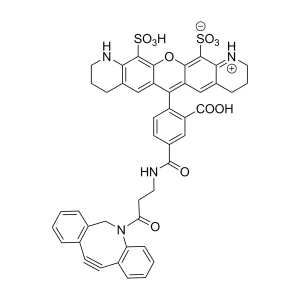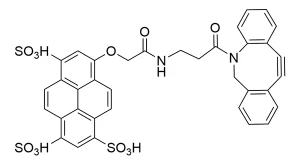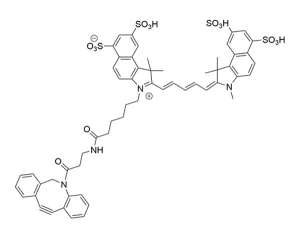DBCO-dPEG®12-carboxyfluorescein, product number QBD-11812, permits fluorescein labeling of peptides, proteins, and other molecules using strain-promoted azide-alkyne cycloaddition (SPAAC). This compound combines the xanthene dye, 5(6)-carboxyfluorescein, with the popular click chemistry alkyne dibenzylcyclooctyne (DBCO) through a medium-length (40 atoms, 47.6 Å), single molecular weight, discrete PEG (dPEG®) spacer. The carboxyfluorescein label has an excitation wavelength (λex) of 498 nanometers (nm), and an emission wavelength (λem) of 528 nm. The molar absorptivity (ε) is 7.96×104 M-1 cm-1 at pH 8.0 and 498 nm.
Fluorescein and its derivatives are among the most popular dyes in use today for labeling proteins and cells. Unfortunately, these dyes are hydrophobic, and care must be taken to avoid over-labeling because over-labeling can result in quenching and possibly aggregation and precipitation of the conjugates through non-specific hydrophobic interactions.
DBCO is an increasingly popular choice for SPAAC chemistry, also known as “”copper-free click chemistry”” because it avoids the use of cytotoxic copper(I) ions and allows reactions to occur in and with living cells. Although DBCO may react with free sulfhydryl groups under some conditions, it is highly selective for azides. Because azides must be introduced artificially into proteins, DBCO is considered a bioorthogonal click chemistry reagent.
The introduction of a flexible dPEG® spacer between carboxyfluorescein and DBCO increases the molecule’s hydrodynamic volume and imparts water solubility to DBCO-dPEG®12-carboxyfluorescein. Thus, DBCO-dPEG®12-carboxyfluorescein provides a highly selective, flexible, water-soluble way to label proteins, peptides, and cells with carboxyfluorescein using a bio-orthogonal reagent designed to simplify analysis and characterization of the conjugate.
| Unit Size | 1 mg, 5 mg |
|---|---|
| Molecular Weight | 1234.34; single compound |
| Chemical formula | C₆₆H₇₉N₃O₂₀ |
| CAS | N/A |
| Purity | > 97% |
| Spacers | dPEG® Spacer is 40 atoms and 47.6 Å |
| Shipping | Ambient |
| Typical solubility properties (for additional information contact Customer Support) | Methylene Chloride, Methanol, DMAC, or DMSO. |
| Storage and handling | -20°C; Always let come to room temperature before opening; be careful to limit exposure to moisture and restore under an inert atmosphere; stock solutions can be prepared with dry solvent and kept for several days (freeze when not in use). dPEG® pegylation compounds are generally hygroscopic and should be treated as such. This will be less noticeable with liquids, but the solids will become tacky and difficult to manipulate, if care is not taken to minimize air exposure. |
Greg T. Hermanson, Bioconjugate Techniques, 2nd Edition, Elsevier Inc., Burlington, MA 01803, April, 2008 (ISBN-13: 978-0-12-370501-3; ISBN-10: 0-12-370501-0). Specifically see pp. 726-729 in his Chapter 18 on discrete PEG compounds for pegylation applications.
Greg T. Hermanson, Bioconjugate Techniques, 3rd Edition, Elsevier, Waltham, MA 02451, 2013, ISBN 978-0-12-382239-0; See chapter 18, Discrete PEG Reagents, pp.787-821, for a full overview of the dPEG® products.
Applicable patents and legal notices are available at legal notices.




Stay in the Loop. Join Our Online Community
Products
Ordering
About Us
Application
Resources

©Vector Laboratories, Inc. 2025 All Rights Reserved.
To provide the best experiences, we use technologies like cookies to store and/or access device information. Consenting to these technologies will allow us to process data such as browsing behavior or unique IDs on this site. Not consenting or withdrawing consent, may adversely affect certain features and functions. Privacy Statement
How do I Request a Quote?
To request a quote for products: